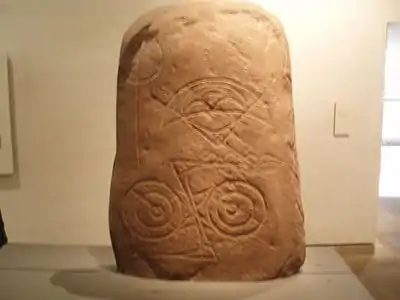Invereen Stone
The Invereen Stone is a Class I incised Pictish stone that was unearthed near Invereen, Inverness in 1932. It is now on display at the National Museums of Scotland, Edinburgh, Scotland.
| The Invereen Stone | |
|---|---|
 The Invereen Stone on display in the National Museums of Scotland | |
| Material | Old Red Sandstone |
| Height | 1.0 metre (3.3 ft) |
| Symbols |
|
| Created | Seventh century CE |
| Discovered | 1932 |
| Place | near Invereen, Moy, Scotland |
| Present location | National Museums of Scotland, Edinburgh, Scotland |
| Classification | Type I |
| Culture | Picto-Scottish |
Description
The stone is of light red sandstone, 1.0 metre (3.3 ft) high, 0.8 metres (2.6 ft) wide and 0.15 metres (0.49 ft) deep. It was unearthed in 1932 by a Mr. A. Dunbar near Invereen (grid reference NH797311) while ploughing.[1] The stone bears a crescent and v-rod symbol and a double disc and z-rod, with a third design of a circle and line, possibly being later in date.[2]
References
- "Invereen, Pictish symbol stone". Canmore database. Retrieved May 20, 2012.
- Fraser, Iain (2008), The Pictish Symbol Stones of Scotland, Edinburgh: Royal Commission on the Ancient and Historic Monuments of Scotland, pp. 82–83
This article is issued from Wikipedia. The text is licensed under Creative Commons - Attribution - Sharealike. Additional terms may apply for the media files.